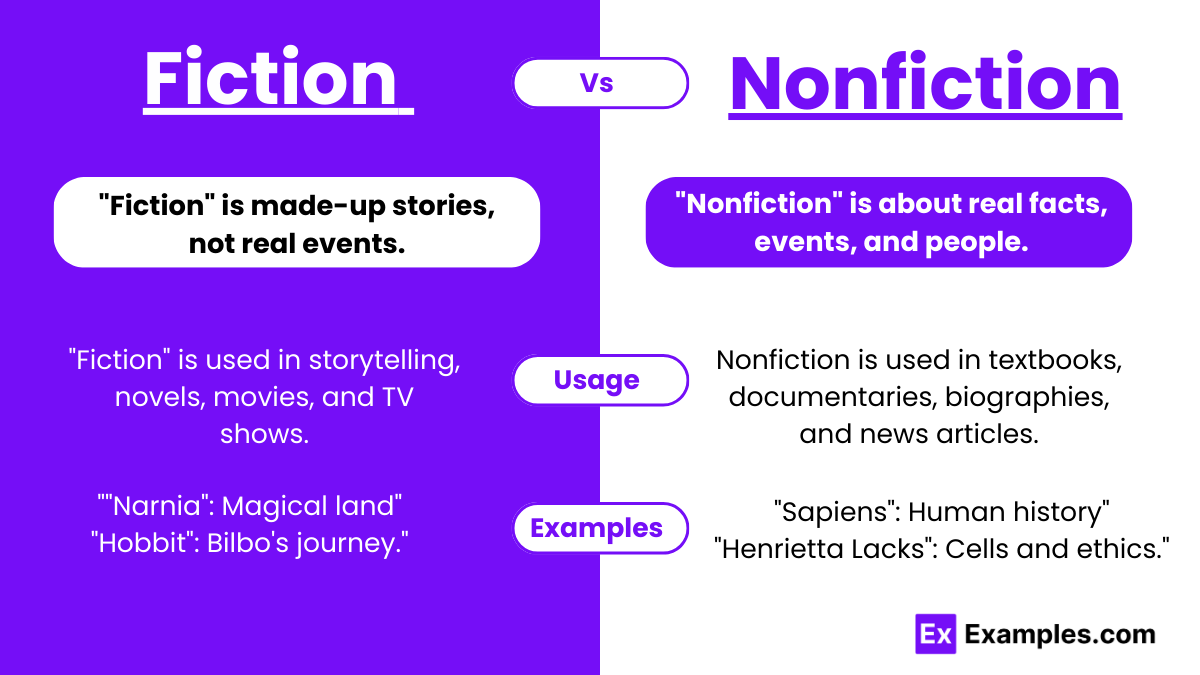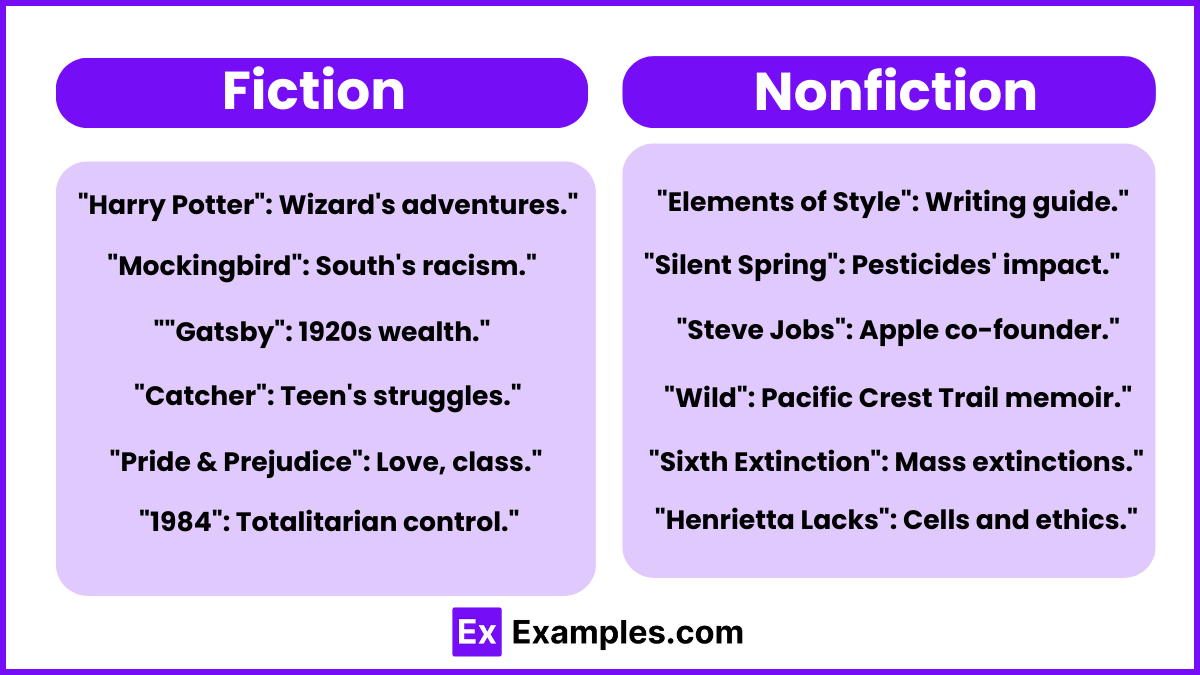Fiction vs Nonfiction – Examples, Differences, Usage, Ideas
Fiction and nonfiction stand as pillars of literary exploration, each offering students a unique lens through which to view the world. Fiction, with its roots deeply embedded in the realms of imagination, invites readers into stories crafted from the boundless creativity of authors. It spans a diverse array of genres, from the thrilling twists of crime thrillers to the heartfelt narratives of romance, allowing readers to traverse a multitude of fabricated realities. Classics like Harper Lee’s “To Kill a Mockingbird” and Jane Austen’s “Pride and Prejudice” exemplify fiction’s timeless allure, presenting tales that resonate with themes of human experience, albeit through invented characters and settings.
On the flip side, nonfiction grounds readers in the tangible and the true, offering insights into real-world phenomena through the meticulous presentation of facts and experiences. This category encompasses a wide spectrum of topics, including history, science, and biography, enabling students to enrich their knowledge and understanding of the world around them. From the detailed recounting of historical events to the practical advice found in self-help books, nonfiction serves as a conduit for information and reality-based storytelling. Through this literary dichotomy, students are equipped with the tools to both imagine worlds beyond their own and engage deeply with the one they inhabit.
What is Fiction?
“Fiction” is a genre of literature that encompasses narratives created from the imagination rather than based on real events. It offers a vast array of sub-genres, including mysteries, science fiction, romance, and fantasy, allowing readers to explore diverse realms of creativity. Through characters, settings, and plots that are devised by authors, fiction has the power to evoke emotions, provoke thought, and entertain. It enables writers to experiment with themes, moral questions, and human experiences, often weaving elements of truth into fabricated stories. Fiction can serve as both an escape and a mirror, reflecting societal values and personal dreams.
What is Nonfiction?
“Nonfiction” is a category of literature that deals with real facts, events, and people. It encompasses a wide range of subjects including history, science, biography, self-help, and more, aiming to inform, educate, or persuade readers through factual content. Unlike fiction, nonfiction narratives are grounded in truth and reality, often backed by research and evidence. This genre offers insights into the world as it is, from detailed explorations of specific topics to personal memoirs and investigative journalism. Through nonfiction, readers gain knowledge, understand different perspectives, and connect with real-life experiences and discoveries.
Summary
Fiction and nonfiction represent two separate genres of writing, each with its own objectives and storytelling methods. Fiction encompasses works derived from an author’s imagination, not tied to actual events or facts. In contrast, nonfiction is centered on true stories, people, and factual information, presenting reality as it is or has been.
Difference Between Fiction and Nonfiction
Understanding the differences between “fiction” and “nonfiction” enhances our appreciation of literature’s spectrum, from the escapist joys of a well-told story to the grounding influence of factual narratives.
| Aspect | Fiction | Nonfiction |
|---|---|---|
| Purpose | Primarily entertains, but can also offer insights into the human condition. | Informs, educates, or documents reality. |
| Content | Invented stories, characters, and settings. | Based on factual information and real events. |
| Creativity | Bound by imagination; allows for fantastical elements. | Restricted by truth and factual accuracy. |
| Narrative Style | Can employ various narrative techniques, including first-person, third-person, unreliable narrators, etc. | Often presented in a structured format, including argumentative, descriptive, and expository styles. |
| Genres | Includes romance, science fiction, fantasy, mystery, and more. | Encompasses biography, history, self-help, documentary, and more. |
| Connection with Reality | May mirror real-life issues or themes in a fabricated context. | Directly relates to and reflects real-life situations and facts. |
| Emotional Impact | Evokes a wide range of emotions through relatable or fantastical plots. | Can inspire, educate, or provoke thought based on real experiences and truths. |
| Flexibility | Plots and characters can diverge from real-world logic or physics. | Adheres to logical and factual consistency based on real-world rules. |
| Sources | Originates from the author’s imagination, possibly inspired by real events or people. | Derived from research, interviews, historical documents, and firsthand experiences. |
| Reader Engagement | Engages readers by encouraging them to imagine and suspend disbelief. | Engages readers through factual revelations, learning, and real-world connections. |
Examples of Fiction and Nonfiction
“Fiction” and “nonfiction” each offer a unique doorway to different worlds: one rooted in the boundless landscape of the imagination, and the other anchored in the tangible truths of our existence. Fiction invites readers into stories where characters, settings, and plots are born from the creative minds of writers, allowing for a diverse exploration of themes and emotions. Nonfiction, by contrast, opens up a realm of knowledge and real-world stories, providing insights into facts, historical events, personal experiences, and more, all grounded in reality.
1. Fantasy: “Harry Potter Series” by J.K. Rowling
2. Dystopian: “1984” by George Orwell
3. Classic Romance: “Pride and Prejudice” by Jane Austen
4. Tragedy: “The Great Gatsby” by F. Scott Fitzgerald
5. Epic Fantasy: “The Lord of the Rings” by J.R.R. Tolkien
Examples of Nonfiction:
1. Science: “A Brief History of Time” by Stephen Hawking
2. Autobiography/Diary: “The Diary of Anne Frank” by Anne Frank
3. History: “Sapiens: A Brief History of Humankind” by Yuval Noah Harari
4. True Crime: “In Cold Blood” by Truman Capote
5. Biography/Science: “The Immortal Life of Henrietta Lacks” by Rebecca Skloot.
When to Use Fiction and Nonfiction
Usage of “Fiction”
1. Entertainment and Escapism:
- Fiction provides a gateway to imaginary worlds, allowing readers to escape the realities of their everyday lives. Novels, short stories, and other forms of fiction offer entertainment by engaging the imagination and transporting readers to different times, places, or universes.
2. Emotional and Psychological Exploration:
- Through characters, conflicts, and narratives, fiction offers a deep dive into the human psyche. Readers can explore complex emotions, psychological states, and moral dilemmas, often finding solace, understanding, or new perspectives on their own experiences.
3. Cultural and Historical Perspectives:
- Fiction, especially historical fiction, can offer insights into different cultures, epochs, and societal norms. It provides a narrative form of learning that can complement traditional historical or cultural studies by humanizing past events and lifestyles.
4. Language and Creativity Enhancement:
- Engaging with fiction can enrich one’s language and boost creativity. The diverse writing styles, vocabularies, and innovative narratives encountered in fiction can inspire readers and writers alike, fostering a deeper appreciation for the art of storytelling.
5. Teaching Empathy and Ethical Reflection:
- Fiction allows readers to step into the shoes of characters from diverse backgrounds and experiences, fostering empathy and understanding. By presenting moral quandaries and character development, fiction can also stimulate ethical reflection and discussion.
Usage of “Nonfiction”
1. Education and Learning:
- Nonfiction is a cornerstone of formal education and lifelong learning. Whether it’s a textbook, a scientific article, or a historical account, nonfiction provides factual information and insights, making it essential for academic research and study.
2. Self-Improvement and Personal Development:
- Nonfiction genres like self-help, biographies, and how-to guides offer practical advice, motivational stories, and strategies for personal growth, making them go-to resources for those looking to improve aspects of their personal or professional lives.
3. Staying Informed and Making Decisions:
- In a rapidly changing world, staying informed about current events, scientific advancements, and global issues is crucial. Nonfiction in the form of news articles, reports, and analytical books helps individuals stay updated and make informed decisions.
4. Understanding Real-World Problems and Solutions:
- Nonfiction books on topics such as economics, politics, and social issues provide in-depth analyses of real-world problems and potential solutions. This genre is essential for those looking to understand complex issues and contribute to societal progress.
5. Professional Expertise and Skills Development:
- For professionals looking to advance in their careers, nonfiction literature in their field can be invaluable. Industry-specific books, journals, and manuals offer insights into best practices, emerging trends, and essential skills, facilitating career development and expertise.
Both fiction and nonfiction have distinct roles in education, personal development, and entertainment. Choosing between them depends on the objectives of the reader, whether they seek to be informed, entertained, or inspired.
Why Do People Read Fiction and Nonfiction?
Reading is a fundamental aspect of human culture and intellectual development, encompassing a wide range of genres and formats. People gravitate towards both fiction and nonfiction for various reasons, from seeking knowledge and understanding to looking for entertainment and emotional resonance. Below, we explore the motivations behind why individuals engage with these two primary categories of literature.
Why People Read “Fiction”
- For Entertainment:
- Fiction offers an escape from the routine of daily life, providing readers with stories that entertain, engage, and sometimes thrill or scare, offering a form of relaxation and amusement.
- To Experience Emotional Journeys:
- Through characters and narratives, fiction allows readers to experience a spectrum of emotions, from love and happiness to sadness and fear, often leading to a cathartic release.
- To Foster Imagination and Creativity:
- Engaging with fictional worlds and characters can stimulate the imagination, encouraging readers to envision new possibilities, scenarios, and solutions, thereby boosting creativity.
- To Gain Insight into the Human Condition:
- Fiction often explores themes related to human nature, relationships, morality, and society, providing readers with deeper insights into their own lives and the lives of others.
- To Cultivate Empathy:
- By inhabiting the perspectives of diverse characters, readers can develop a greater understanding and empathy for people from different backgrounds, circumstances, and cultures.
Why People Read “Nonfiction”
- To Acquire Knowledge and Learn:
- Nonfiction encompasses a vast array of topics, including history, science, and philosophy, offering readers the opportunity to learn new information, understand complex concepts, and gain expertise in various subjects.
- For Personal Development:
- Many turn to nonfiction for guidance on personal growth, self-improvement, and skill enhancement, seeking practical advice and strategies to better themselves.
- To Stay Informed:
- Nonfiction in the form of news, analysis, and commentary provides individuals with current information about world events, societal trends, and important issues, helping them stay informed and aware.
- For Professional Advancement:
- Professionals often read nonfiction to keep up with industry trends, best practices, and innovations, aiming to enhance their skills and advance their careers.
- To Understand Real-World Issues:
- Nonfiction literature offers in-depth exploration of social, political, and economic issues, enabling readers to understand complex problems and consider potential solutions.





